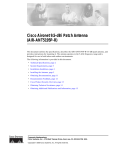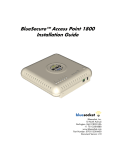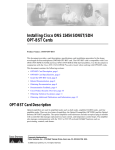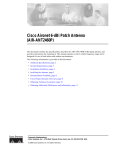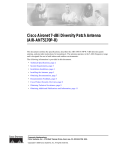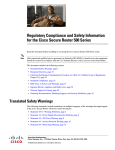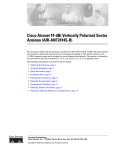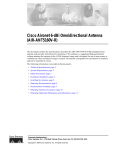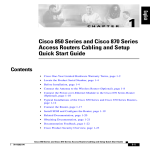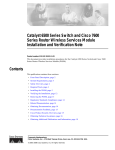Download Cisco AIR-ANT2410Y-R Specifications
Transcript
Cisco Aironet 10-dBi Yagi Antenna (AIR-ANT2410Y-R) This document describes the AIR-ANT2410Y-R 10-dBi Yagi antenna and provides instructions for mounting it. The antenna operates in the 2.4- to 2.48-GHz frequency range and is designed for use as an access point or bridge antenna. The antenna is an enclosed 6-element, vertically polarized directional Yagi and is designed to be mounted indoors or outdoors on a mast or flat vertical surface. The following information is provided in this document. • Technical Specifications, page 2 • Safety Precautions, page 3 • Installation Notes, page 4 • Obtaining Documentation, page 10 • Documentation Feedback, page 11 • Cisco Product Security Overview, page 11 • Obtaining Technical Assistance, page 12 • Obtaining Additional Publications and Information, page 14 • Translated Safety Warnings, page 15 Corporate Headquarters: Cisco Systems, Inc., 170 West Tasman Drive, San Jose, CA 95134-1706 USA © 2006 Cisco Systems, Inc. All rights reserved. Technical Specifications Antenna type Yagi Operating frequency range 2400 – 2485 MHz Nominal input impedence 50Ω VSWR < 1.5:1 (VSWR) Gain 10 dBi Polarization Vertical or horizontal, linear Horizontal plane 3 dB beamwidth 55 Vertical plane 3 dB beamwidth 55 Front-to-back ratio 23 dB Maximum side lobe level Less than –16 dB Dimensions 6.75 in. L x 3 in. OD (17.14 cm x 76 cm) Diameter 3 in. (7.6 cm) Cable length and type 3 ft. (0.91 m) low loss RG-58 Connector type RP-TNC Mounting options Mast or wall mount Operating temperature 140 F to –40 F (60 C to –40 C) Wind rating 125 MPH (201.2 KMPH) Azimuth Radiation Pattern Elevation Radiation Pattern Cisco Aironet 10-dBi Yagi Antenna (AIR-ANT2410Y-R) 2 78-16122-01 System Requirements This antenna is designed for use with Cisco Aironet access points and bridges but can be used with any 2.4-GHz Cisco Aironet radio device that uses an RP-TNC connector. Safety Precautions Warning In order to comply with FCC radio frequency (RF) exposure limits, antennas should be located at a minimum of 7.9 inches (20 cm) or more from the body of all persons. Statement 332 Each year hundreds of people are killed or injured when attempting to install an antenna. In many of these cases, the victim was aware of the danger of electrocution, but did not take adequate steps to avoid the hazard. For your safety, and to help you achieve a good installation, please read and follow these safety precautions. They may save your life! 1. If you are installing an antenna for the first time, for your own safety as well as others, seek professional assistance. Your Cisco sales representative can explain which mounting method to use for the size and type antenna you are about to install. 2. Select your installation site with safety, as well as performance in mind. Remember: electric power lines and phone lines look alike. For your safety, assume that any overhead line can kill you. 3. Call your electric power company. Tell them your plans and ask them to come look at your proposed installation. This is a small inconvenience considering your life is at stake. 4. Plan your installation carefully and completely before you begin. Successful raising of a mast or tower is largely a matter of coordination. Each person should be assigned to a specific task, and should know what to do and when to do it. One person should be in charge of the operation to issue instructions and watch for signs of trouble. 5. When installing your antenna, remember: a. Do not use a metal ladder. b. Do not work on a wet or windy day. c. Do dress properly—shoes with rubber soles and heels, rubber gloves, long sleeved shirt or jacket. 6. If the assembly starts to drop, get away from it and let it fall. Remember, the antenna, mast, cable, and metal guy wires are all excellent conductors of electrical current. Even the slightest touch of any of these parts to a power line complete an electrical path through the antenna and the installer: you! 7. If any part of the antenna system should come in contact with a power line, don’t touch it or try to remove it yourself. Call your local power company. They will remove it safely. 8. If an accident should occur with the power lines call for qualified emergency help immediately. Cisco Aironet 10-dBi Yagi Antenna (AIR-ANT2410Y-R) 78-16122-01 3 Installation Notes General Installation Instructions for Mast-Mounted Antennas The following instructions are common to most mast-mounted installations. Step 1 Assemble your new antenna on the ground at the installation site. Step 2 Attach the antenna to the mast and connect its coaxial cable while you are on the ground. Step 3 If you lose control of the mast while raising it, make sure that it does not fall in the wrong direction. Use a durable non-conductive rope secured at each 2-foot level as the mast is raised. Have an assistant tend the rope, ready to pull the mast clear of any hazards (such as power lines) if it begins to fall. Step 4 Use the mounting bracket and hardware provided with the antenna. Step 5 If the installation will use guy wires: Step 6 a. Install guy anchor bolts. b. Estimate the length of guy wire and cut it before raising the mast. c. Attach guy wires to a mast using guy rings. Carefully connect the antenna and mast assembly to its mounting bracket and tighten the clamp bolts. a. For a guyed installation, you must have at least one assistant to hold the mast upright while you attach and tighten the guy wires to the anchor bolts. Step 7 Attach the provided self-adhering DANGER label at eye level on the mast. Step 8 Install ground rods to remove any static electricity buildup and connect a ground wire to the mast and ground rod. Use ground rods designed for that purpose, not a spare piece of pipe. Grounding the Antenna Follow these steps to ground the antenna in accordance with national electrical code instructions. Step 1 Use No. 10 AWG copper or No. 8 or larger copper-clad steel or bronze wire as ground wires for both mast and lead-in. Securely clamp the wire to the bottom of the mast. Step 2 Secure the lead-in wire to an antenna discharge unit and the mast ground wire to the building with stand-off insulators spaced from 4 ft (1.2 m) to 8 ft (2.4 m) apart. Step 3 Mount the antenna discharge unit as closely as possible to where the lead-in wire enters the building. Step 4 Drill a hole in the building’s wall as closely as possible to the equipment to which you will connect the lead-in cable. Caution There may be wires in the wall. Make sure your drilling location is clear of any obstructions or other hazards. Step 5 Pull the cable through the hole and form a drip loop close to where it enters the building. Step 6 Thoroughly waterproof the lead-in area. Cisco Aironet 10-dBi Yagi Antenna (AIR-ANT2410Y-R) 4 78-16122-01 Step 7 Install a lightning arrestor. Step 8 Connect the lead-in cable to the equipment. Choosing a Mounting Location The antenna is designed to create a directional broadcast pattern. To achieve this pattern, the antenna should be mounted clear of any obstructions to the sides of the radiating element. If the mounting location is on the side of a building or tower, the antenna pattern is degraded on the building or tower side. Site Selection Before attempting to install your antenna, determine where you can best place the antenna for safety and performance. Follow these steps to determine a safe distance from wires, power lines, and trees. Step 1 Measure the height of your antenna. Step 2 Add this length to the length of your tower or mast and then double this total for the minimum recommended safe distance. Caution If you are unable to maintain this safe distance, stop and get professional help. Generally, the higher an antenna is above the ground, the better it performs. Good practice is to install your antenna about 5 to 10 ft (1.5 to 3 m) above the roof line and away from all power lines and obstructions. If possible, find a mounting place directly above your wireless device so that the lead-in cable can be as short as possible. Note The antenna can also be mounted on a wall or other flat vertical surface. Mounting hardware is not provided. Tools and Equipment Required A mast mounting installation kit is shipped with the antenna. To install the antenna on a mast, you need the following tools and equipment. • A 5/16-in. (8 mm) wrench or suitable adjustable wrench • A 5/16-in. (8 mm) hex allen wrench (if you need to change the antenna polarity) • A small standard screw driver (if you need to change the antenna polarity) • Cable ties and electrical tape Cisco Aironet 10-dBi Yagi Antenna (AIR-ANT2410Y-R) 78-16122-01 5 Note The antenna can also be mounted on a wall or other flat vertical surface. Mounting hardware is not provided. The following section contains a typical procedure for installing the antenna on a mast. Your installation may vary. Before you begin, you may want to refer to Figure 1. Mounting the Antenna Figure 1 shows how the antenna should be mounted on a mast. Figure 1 Antenna Mounting Details 1 Horizontal polarization arrow 5 Spring lock washers, flat washer, and hex nuts 2 Vertical polarization arrow 6 Antenna mounting plate 3 U-bolt 7 Coaxial cable 4 V-block 8 RP-TNC connector Cisco Aironet 10-dBi Yagi Antenna (AIR-ANT2410Y-R) 6 78-16122-01 Mounting on a Mast Follow these instructions to mount the antenna on a mast. Step 1 Remove the bag of hardware from the shipping carton and verify that it contains the following hardware: a. Two V blocks b. Two U bolts c. Four 5/16-18 hex nuts d. Four flat washers e. Four spring lock washers f. One piece of sealant wrap Step 2 Place a U bolt around the mast and place a V block on the U bolt. Step 3 Place the holes in the top flange of the antenna on the U bolt. a. Note Make sure the antenna is positioned so that the arrow labelled V-POL is pointing up. The uncovered drain holes will on at the bottom of the antenna radome and the covered drain holes will be on the side. The antenna ships in the vertical polarization mode. but you can mount it in the horizontal polarization mode. See the “Changing the Polarization” section on page 8 for instructions. Step 4 Place a spring lock washer and flat washer on each end of the U bolt Step 5 Start a 5/16-18 hex nut on each end of the U bolt and tighten finger tight. Step 6 Repeat Steps 2 through 5 for the bottom flange of the antenna. Step 7 Rotate the antenna until it points towards the other WLAN antenna your wireless device is to communicate with. Note The accuracy of the orientation should be within 15 degrees to achieve maximum gain. This is especially important if the path length is over 1 mile (1.6 kilometers). If you use this antenna to Connect to several terminals, aim it in the general direction of the group. If the paths are not obstructed or are less than 1 mile (1.6 kilometers), this arrangement should work well. Step 8 Use a 5/16-in (8-mm) wrench or suitable adjustable wrench to tighten the assembly to the mast. Tighten the hex nuts evenly. Do not overtighten. Step 9 Secure the antenna cable to the mast with cable ties or electrical tape. Step 10 Remove the paper backing from the sealant tape and wrap the connectors. Start wrapping 1/2-in (13 mm) above the top connector. Stretch the tape tight and continue wrapping to 1/2-in (13 mm) below the bottom connector. Step 11 Wrap the sealant tape with electrical tape. Cisco Aironet 10-dBi Yagi Antenna (AIR-ANT2410Y-R) 78-16122-01 7 Note The antenna is DC grounded. However, Cisco recommends that you install lightning-protection devices in your system. See the Installation Instructions for Cisco Aironet Lightning Arrestors. This document is available on the World Wide Web at the following URL: http://www.cisco.com/en/US/products/hw/wireless/ps469/prod_installation_guide09186a 008007f86e.html Changing the Polarization You can change the antenna polarization to horizontal or vertical. The antenna ships in the verticalpolarization. You will need a 5/32-in (4 mm) hex allen wrench and a small standard screw driver to perform this task. Follow these steps to change to the horizontal mode: Step 1 Use a 5/32-in (4 mm) hex allen wrench to remove the 4 cap screws from the base of the antenna. Step 2 Rotate the antenna so that the arrow labelled H-POL is pointing up. The two covered drain holes will be on the bottom of the antenna radome and the two uncovered drain holes will be on the side. Step 3 Use a small standard screw driver to remove the plugs from the drain holes on the bottom of the radome Step 4 Re-install the plugs in the drain holes on the side of the radome. Mounting on a Wall A smooth, flat wall surface must be provided for the antenna mount. On rough wall surfaces such as brick or stucco, use a smooth spacer (wood or metal plate) between the antenna mounting plate and the surface. The intermediate spacer needs to be strong enough to prevent distortion of the antenna mounting plate when you tighten the mounting hardware. Follow these steps to mount the antenna on a flat surface: Step 1 Determine a location on the wall for mounting the antenna. Note Step 2 The accuracy of the orientation is not as critical as it is for an outdoor installation, but the antenna should still be oriented as closely as possible in the direction in which you intend to communicate. If the surface is rough, mount an intermediate spacer. Note Be sure to use appropriate mounting hardware (anchors, toggle bolts, etc.) to mount the spacer to the wall surface. Step 3 Position the mounting plate on the wall or intermediate spacer and use it as a template to locate and mark the antenna mounting holes. Step 4 Drill four holes at the locations you marked. Cisco Aironet 10-dBi Yagi Antenna (AIR-ANT2410Y-R) 8 78-16122-01 Step 5 Position the antenna and antenna mounting plate over the holes. Step 6 Start the fasteners into the holes. Step 7 Use a suitable wrench to secure the assembly to the surface and tighten the fasteners. Do not overtighten. Step 8 Apply the danger label to a plainly visible area adjacent to the antenna. Note The antenna is DC grounded. It is recommended that you install lightning-protection devices in your system. See the Installation Instructions for Cisco Aironet Lightning Arrestors. This document is available on the World Wide Web at the following URL: http://www.cisco.com/en/US/products/hw/wireless/ps469/prod_installation_guide09186a 008007f86e.html Suggested Cable Cisco recommends a high-quality, low-loss cable for use with the antenna. Note Coaxial cable loses efficiency as the frequency increases, resulting in signal loss. The cable should be kept as short as possible because cable length also determines the amount of signal loss (the longer the run, the greater the loss). The antenna terminates with a RP-TNC plug after a short, 3-ft (0.91-m) cable. The mating connector to the antenna is an appropriate RP-TNC jack. The connector on the opposite end will vary according to the type of equipment used. After the cable is attached to the antenna, make sure that the connections are sealed (if outdoors) to prevent moisture and other weathering elements from affecting performance. Cisco recommends using a coax seal (such as CoaxSeal) for outdoor connections. Silicon sealant or electrical tape are not recommended for sealing outdoor connections. Cisco Aironet 10-dBi Yagi Antenna (AIR-ANT2410Y-R) 78-16122-01 9 Obtaining Documentation Cisco documentation and additional literature are available on Cisco.com. Cisco also provides several ways to obtain technical assistance and other technical resources. These sections explain how to obtain technical information from Cisco Systems. Cisco.com You can access the most current Cisco documentation at this URL: http://www.cisco.com/techsupport You can access the Cisco website at this URL: http://www.cisco.com You can access international Cisco websites at this URL: http://www.cisco.com/public/countries_languages.shtml Product Documentation DVD Cisco documentation and additional literature are available in the Product Documentation DVD package, which may have shipped with your product. The Product Documentation DVD is updated regularly and may be more current than printed documentation. The Product Documentation DVD is a comprehensive library of technical product documentation on portable media. The DVD enables you to access multiple versions of hardware and software installation, configuration, and command guides for Cisco products and to view technical documentation in HTML. With the DVD, you have access to the same documentation that is found on the Cisco website without being connected to the Internet. Certain products also have .pdf versions of the documentation available. The Product Documentation DVD is available as a single unit or as a subscription. Registered Cisco.com users (Cisco direct customers) can order a Product Documentation DVD (product number DOC-DOCDVD=) from the Ordering tool or Cisco Marketplace. Cisco Ordering tool: http://www.cisco.com/en/US/partner/ordering/ Cisco Marketplace: http://www.cisco.com/go/marketplace/ Ordering Documentation Beginning June 30, 2005, registered Cisco.com users may order Cisco documentation at the Product Documentation Store in the Cisco Marketplace at this URL: http://www.cisco.com/go/marketplace/ Cisco will continue to support documentation orders using the Ordering tool: • Registered Cisco.com users (Cisco direct customers) can order documentation from the Ordering tool: http://www.cisco.com/en/US/partner/ordering/ Cisco Aironet 10-dBi Yagi Antenna (AIR-ANT2410Y-R) 10 78-16122-01 • Instructions for ordering documentation using the Ordering tool are at this URL: http://www.cisco.com/univercd/cc/td/doc/es_inpck/pdi.htm • Nonregistered Cisco.com users can order documentation through a local account representative by calling Cisco Systems Corporate Headquarters (California, USA) at 408 526-7208 or, elsewhere in North America, by calling 1 800 553-NETS (6387). Documentation Feedback You can rate and provide feedback about Cisco technical documents by completing the online feedback form that appears with the technical documents on Cisco.com. You can send comments about Cisco documentation to [email protected]. You can submit comments by using the response card (if present) behind the front cover of your document or by writing to the following address: Cisco Systems Attn: Customer Document Ordering 170 West Tasman Drive San Jose, CA 95134-9883 We appreciate your comments. Cisco Product Security Overview Cisco provides a free online Security Vulnerability Policy portal at this URL: http://www.cisco.com/en/US/products/products_security_vulnerability_policy.html From this site, you can perform these tasks: • Report security vulnerabilities in Cisco products. • Obtain assistance with security incidents that involve Cisco products. • Register to receive security information from Cisco. A current list of security advisories and notices for Cisco products is available at this URL: http://www.cisco.com/go/psirt If you prefer to see advisories and notices as they are updated in real time, you can access a Product Security Incident Response Team Really Simple Syndication (PSIRT RSS) feed from this URL: http://www.cisco.com/en/US/products/products_psirt_rss_feed.html Cisco Aironet 10-dBi Yagi Antenna (AIR-ANT2410Y-R) 78-16122-01 11 Reporting Security Problems in Cisco Products Cisco is committed to delivering secure products. We test our products internally before we release them, and we strive to correct all vulnerabilities quickly. If you think that you might have identified a vulnerability in a Cisco product, contact PSIRT: • Emergencies — [email protected] An emergency is either a condition in which a system is under active attack or a condition for which a severe and urgent security vulnerability should be reported. All other conditions are considered nonemergencies. • Nonemergencies — [email protected] In an emergency, you can also reach PSIRT by telephone: Tip • 1 877 228-7302 • 1 408 525-6532 We encourage you to use Pretty Good Privacy (PGP) or a compatible product to encrypt any sensitive information that you send to Cisco. PSIRT can work from encrypted information that is compatible with PGP versions 2.x through 8.x. Never use a revoked or an expired encryption key. The correct public key to use in your correspondence with PSIRT is the one linked in the Contact Summary section of the Security Vulnerability Policy page at this URL: http://www.cisco.com/en/US/products/products_security_vulnerability_policy.htm The link on this page has the current PGP key ID in use. Obtaining Technical Assistance Cisco Technical Support provides 24-hour-a-day award-winning technical assistance. The Cisco Technical Support & Documentation website on Cisco.com features extensive online support resources. In addition, if you have a valid Cisco service contract, Cisco Technical Assistance Center (TAC) engineers provide telephone support. If you do not have a valid Cisco service contract, contact your reseller. Cisco Technical Support & Documentation Website The Cisco Technical Support & Documentation website provides online documents and tools for troubleshooting and resolving technical issues with Cisco products and technologies. The website is available 24 hours a day, at this URL: http://www.cisco.com/techsupport Access to all tools on the Cisco Technical Support & Documentation website requires a Cisco.com user ID and password. If you have a valid service contract but do not have a user ID or password, you can register at this URL: http://tools.cisco.com/RPF/register/register.do Cisco Aironet 10-dBi Yagi Antenna (AIR-ANT2410Y-R) 12 78-16122-01 Note Use the Cisco Product Identification (CPI) tool to locate your product serial number before submitting a web or phone request for service. You can access the CPI tool from the Cisco Technical Support & Documentation website by clicking the Tools & Resources link under Documentation & Tools. Choose Cisco Product Identification Tool from the Alphabetical Index drop-down list, or click the Cisco Product Identification Tool link under Alerts & RMAs. The CPI tool offers three search options: by product ID or model name; by tree view; or for certain products, by copying and pasting show command output. Search results show an illustration of your product with the serial number label location highlighted. Locate the serial number label on your product and record the information before placing a service call. Submitting a Service Request Using the online TAC Service Request Tool is the fastest way to open S3 and S4 service requests. (S3 and S4 service requests are those in which your network is minimally impaired or for which you require product information.) After you describe your situation, the TAC Service Request Tool provides recommended solutions. If your issue is not resolved using the recommended resources, your service request is assigned to a Cisco engineer. The TAC Service Request Tool is located at this URL: http://www.cisco.com/techsupport/servicerequest For S1 or S2 service requests or if you do not have Internet access, contact the Cisco TAC by telephone. (S1 or S2 service requests are those in which your production network is down or severely degraded.) Cisco engineers are assigned immediately to S1 and S2 service requests to help keep your business operations running smoothly. To open a service request by telephone, use one of the following numbers: Asia-Pacific: +61 2 8446 7411 (Australia: 1 800 805 227) EMEA: +32 2 704 55 55 USA: 1 800 553-2447 For a complete list of Cisco TAC contacts, go to this URL: http://www.cisco.com/techsupport/contacts Definitions of Service Request Severity To ensure that all service requests are reported in a standard format, Cisco has established severity definitions. Severity 1 (S1)—Your network is “down,” or there is a critical impact to your business operations. You and Cisco will commit all necessary resources around the clock to resolve the situation. Severity 2 (S2)—Operation of an existing network is severely degraded, or significant aspects of your business operation are negatively affected by inadequate performance of Cisco products. You and Cisco will commit full-time resources during normal business hours to resolve the situation. Severity 3 (S3)—Operational performance of your network is impaired, but most business operations remain functional. You and Cisco will commit resources during normal business hours to restore service to satisfactory levels. Severity 4 (S4)—You require information or assistance with Cisco product capabilities, installation, or configuration. There is little or no effect on your business operations. Cisco Aironet 10-dBi Yagi Antenna (AIR-ANT2410Y-R) 78-16122-01 13 Obtaining Additional Publications and Information Information about Cisco products, technologies, and network solutions is available from various online and printed sources. • Cisco Marketplace provides a variety of Cisco books, reference guides, documentation, and logo merchandise. Visit Cisco Marketplace, the company store, at this URL: http://www.cisco.com/go/marketplace/ • Cisco Press publishes a wide range of general networking, training and certification titles. Both new and experienced users will benefit from these publications. For current Cisco Press titles and other information, go to Cisco Press at this URL: http://www.ciscopress.com • Packet magazine is the Cisco Systems technical user magazine for maximizing Internet and networking investments. Each quarter, Packet delivers coverage of the latest industry trends, technology breakthroughs, and Cisco products and solutions, as well as network deployment and troubleshooting tips, configuration examples, customer case studies, certification and training information, and links to scores of in-depth online resources. You can access Packet magazine at this URL: http://www.cisco.com/packet • iQ Magazine is the quarterly publication from Cisco Systems designed to help growing companies learn how they can use technology to increase revenue, streamline their business, and expand services. The publication identifies the challenges facing these companies and the technologies to help solve them, using real-world case studies and business strategies to help readers make sound technology investment decisions. You can access iQ Magazine at this URL: http://www.cisco.com/go/iqmagazine or view the digital edition at this URL: http://ciscoiq.texterity.com/ciscoiq/sample/ • Internet Protocol Journal is a quarterly journal published by Cisco Systems for engineering professionals involved in designing, developing, and operating public and private internets and intranets. You can access the Internet Protocol Journal at this URL: http://www.cisco.com/ipj • Networking products offered by Cisco Systems, as well as customer support services, can be obtained at this URL: http://www.cisco.com/en/US/products/index.html • Networking Professionals Connection is an interactive website for networking professionals to share questions, suggestions, and information about networking products and technologies with Cisco experts and other networking professionals. Join a discussion at this URL: http://www.cisco.com/discuss/networking • World-class networking training is available from Cisco. You can view current offerings at this URL: http://www.cisco.com/en/US/learning/index.html Cisco Aironet 10-dBi Yagi Antenna (AIR-ANT2410Y-R) 14 78-16122-01 Translated Safety Warnings This section provides translations of the safety warnings that appear in this publication. These translated safety warnings apply to other documents in which they appear in English. The following safety warnings appear in this section: • Statement 332—Antenna Installation Warning Statement 332—Antenna Installation Warning Warning In order to comply with FCC radio frequency (RF) exposure limits, antennas should be located at a minimum of 7.9 inches (20 cm) or more from the body of all persons. Statement 332 Waarschuwing Om te voldoen aan de FCC radiofrequentie (RF) blootstellingslimieten dienen antennes zich minstens 20 cm of meer van de lichamen van alle personen bevinden. Varoitus FCC:n antamien radiotaajuuksille altistumista koskevien rajoitusten mukaan antennien on sijaittava vähintään 20 cm:n päässä kaikista henkilöistä. Attention Pour se conformer aux limites d'exposition à la fréquence radio préconisées par la FCC (Federal Communications Commission), les antennes doivent se situer à un minimum de 20 cm de toute personne. Warnung Um die in den FCC-Richtlinien festgelegten Expositionshöchstgrenzen für Radiofrequenzen (RF) nicht zu überschreiten, sollten Antennen mindestens 20 cm entfernt von Personen aufgestellt werden. Avvertenza Advarsel Per conformarsi ai limiti FCC di esposizione a radiofrequenza (RF), le antenne devono stare ad una distanza minima di 20 cm dal corpo di ogni persona. I henhold til eksponeringsgrensene for radiofrekvenser (RF), skal antenner befinne seg på en avstand av minst 20 cm eller mer fra mennesker. Aviso Para estar de acordo com as normas FCC de limites de exposição para freqüência de rádio (RF), as antenas devem estar distantes no mínimo 20 cm (7,9 pol) do corpo de qualquer pessoa. ¡Advertencia! Para cumplir con los límites de exposición de radio frecuencia (RF) de la Comisión Federal de Comunicaciones (FCC) es preciso ubicar las antenas a un mínimo de 20 cm (7,9 pulgadas) o más del cuerpo de las personas. Varning! För att följa FCC-exponeringsgränserna för radiofrekvens (RF), bör antenner placeras på minst 20 cm avstånd från alla människor. Cisco Aironet 10-dBi Yagi Antenna (AIR-ANT2410Y-R) 78-16122-01 15 CCSP, CCVP, the Cisco Square Bridge logo, Follow Me Browsing, and StackWise are trademarks of Cisco Systems, Inc.; Changing the Way We Work, Live, Play, and Learn, and iQuick Study are service marks of Cisco Systems, Inc.; and Access Registrar, Aironet, BPX, Catalyst, CCDA, CCDP, CCIE, CCIP, CCNA, CCNP, Cisco, the Cisco Certified Internetwork Expert logo, Cisco IOS, Cisco Press, Cisco Systems, Cisco Systems Capital, the Cisco Systems logo, Cisco Unity, Enterprise/Solver, EtherChannel, EtherFast, EtherSwitch, Fast Step, FormShare, GigaDrive, GigaStack, HomeLink, Internet Quotient, IOS, IP/TV, iQ Expertise, the iQ logo, iQ Net Readiness Scorecard, LightStream, Linksys, MeetingPlace, MGX, the Networkers logo, Networking Academy, Network Registrar, Packet, PIX, Post-Routing, Pre-Routing, ProConnect, RateMUX, ScriptShare, SlideCast, SMARTnet, The Fastest Way to Increase Your Internet Quotient, and TransPath are registered trademarks of Cisco Systems, Inc. and/or its affiliates in the United States and certain other countries. All other trademarks mentioned in this document or Website are the property of their respective owners. The use of the word partner does not imply a partnership relationship between Cisco and any other company. (0601R) Cisco Aironet 10-dBi Yagi Antenna (AIR-ANT2410Y-R) 16 78-16122-01
















